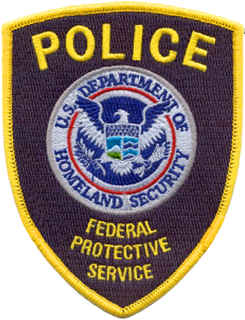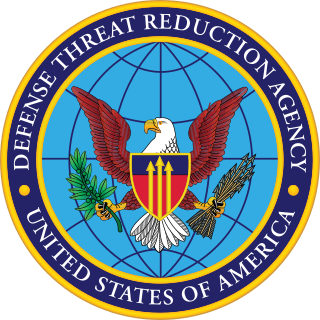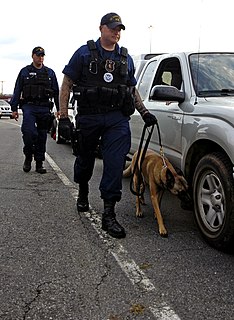
A weapon of mass destruction (WMD) is a nuclear, radiological, chemical, biological, or any other weapon that can kill and bring significant harm to numerous humans or cause great damage to human-made structures, natural structures, or the biosphere. The scope and usage of the term has evolved and been disputed, often signifying more politically than technically. Originally coined in reference to aerial bombing with chemical explosives during World War II, it has later come to refer to large-scale weaponry of other technologies, such as chemical, biological, radiological, or nuclear warfare.

Chemical, biological, radiological and nuclear defense are protective measures taken in situations in which chemical, biological, radiological or nuclear warfare hazards may be present. CBRN defense consists of CBRN passive protection, contamination avoidance and CBRN mitigation.

The Federal Protective Service (FPS) is the uniformed security police division of the United States Department of Homeland Security. FPS is "the federal agency charged with protecting and delivering integrated law enforcement and security services to facilities owned or leased by the General Services Administration (GSA)"—over 9,000 buildings—and their occupants.

The Defense Threat Reduction Agency (DTRA) is an agency within the United States Department of Defense (DoD) and is the official Combat Support Agency for countering weapons of mass destruction. According to the agency's Strategic Plan for Fiscal Years 2018 to 2022, the DTRA mission "enables DoD and the U.S. Government to prepare for and combat weapons of mass destruction and improvised threats and to ensure nuclear deterrence." The agency is headquartered in Fort Belvoir, Virginia.

The United States Postal Inspection Service (USPIS) or the Postal Inspectors, is the law enforcement arm of the United States Postal Service. Its jurisdiction is defined as "crimes that may adversely affect or fraudulently use the U.S. Mail, the postal system or postal employees." The mission of the U.S. Postal Inspection Service is to support and protect the U.S. Postal Service, its employees, infrastructure, and customers by enforcing the laws that defend the nation's mail system from illegal or dangerous use.

United States Navy Explosive Ordnance Disposal technicians render safe all types of ordnance, including improvised, chemical, biological, and nuclear. They perform land and underwater location, identification, render-safe, and recovery of foreign and domestic ordnance. They conduct demolition of hazardous munitions, pyrotechnics, and retrograde explosives using detonation and burning techniques. They forward deploy and fully integrate with the various Combatant Commanders, Special Operations Forces (SOF), and various warfare units within the Navy, Marine Corps, Air Force and Army. They are also called upon to support military and civilian law enforcement agencies, as well as the Secret Service.

PackBot is a series of military robots by Endeavor Robotics, an international robotics company founded in 2016, created from iRobot, that previously produced military robots since 1990. More than 2000 were used in Iraq and Afghanistan. They were also used to aid searching through the debris of the World Trade Center after 9/11 in 2001. Another instance of the PackBot technology being implemented was to the damaged Fukushima nuclear plant after the 2011 Tōhoku earthquake and tsunami where they were the first to assess the site. As of November 2014, the U.S. Army is refurbishing 224 iRobot 510 robots. The PackBot technology is also used in collaboration with NASA for their rovers and probes.

The Special Operations Engineer Regiment (SOER) is a specialised unit of the Australian Army. The Regiment forms part of the Special Operations Command. The unit was formed in 2002 as the Incident Response Regiment (IRR), they are deployed to respond to chemical, biological, radiological, nuclear or explosive incidents. The Regiment was transferred into the newly raised Special Operations Command in 2003. In 2010 and 2011 its role changed to supporting the army's special forces units, and it was renamed accordingly.

Visit, board, search, and seizure (VBSS) is the term used by United States military and law enforcement agencies for maritime boarding actions and tactics. VBSS teams are designed to capture enemy vessels, combat terrorism, piracy and smuggling, and to conduct customs, safety and other inspections.

A full-body scanner is a device that detects objects on a person's body for security screening purposes, without physically removing clothes or making physical contact. Depending on the technology used, the operator may see an alternate-wavelength image of the person's naked body, or merely a cartoon-like representation of the person with an indicator showing where any suspicious items were detected. For privacy and security reasons, the display is generally not visible to other passengers, and in some cases is located in a separate room where the operator cannot see the face of the person being screened. Unlike metal detectors, full-body scanners can detect non-metal objects, which became an increasing concern after various airliner bombing attempts in the 2000s.

Autonomous Detection Systems (ADS), also called biohazard detection systems, or autonomous pathogen detection systems are designed to monitor air in an environment and to detect the presence of airborne chemicals, toxins, pathogens, or other biological agents capable of causing human illness or death. These systems monitor the air continuously and send real-time alerts to appropriate authorities in the event of an act of bioterrorism or biological warfare.

The 20th CBRNE Command is the United States Army's Chemical, Biological, Nuclear, Radiological and high-yield explosives headquarters.

The Chemical Biological Incident Response Force (CBIRF) is a unit in the United States Marine Corps responsible for countering the effects of a chemical, biological, radiological, nuclear, or high-yield explosive (CBRNE) incident. They were activated in April 1996 by General Charles C. Krulak, then Commandant of the Marine Corps. The unit is based at Naval Support Facility Indian Head in Indian Head, Maryland and falls under the command of the United States Marine Corps Forces Command.
The Domestic Nuclear Detection Office (DNDO) is a jointly staffed office established April 15, 2005 by the United States to improve the nation’s capability to detect and report unauthorized attempts to import, possess, store, develop, or transport nuclear or radiological material for use against the nation, and to further enhance this capability over time.

The U.S. Army Edgewood Chemical Biological Center (ECBC) is the United States’s principal research and development resource for non-medical chemical and biological (CB) defense. As a critical national asset in the CB defense community, ECBC supports all phases of the acquisition life-cycle ― from basic and applied research through technology development, engineering design, equipment evaluation, product support, sustainment, field operations and demilitarization ― to address its customers’ unique requirements.

The Deployable Operations Group (DOG) was a United States Coast Guard command that provided properly equipped, trained and organized Deployable Specialized Forces (DSF), which still exist today, to the Coast Guard, DHS, DoD and inter-agency operational and tactical commanders. Formerly headquartered in Arlington, Virginia, it was established on 20 July 2007, and was commanded by a captain and was decommissioned by the Commandant of the Coast Guard, Admiral Robert Papp on 1 October 2013, although many of the units existed long before the 2007 commissioning. Upon decommissioning, the units previously assigned to the DOG were split between Coast Guard Pacific and Atlantic Area commands.
The Domestic Emergency Support Team (DEST) is a rapidly deployable, interagency team of experts within the United States government, staffed from the Federal Bureau of Investigation (FBI), the Federal Emergency Management Agency (FEMA), the Department of Defense (DoD), the Department of Energy (DOE), the Department of Health and Human Services (HHS), and the Environmental Protection Agency (EPA). The DEST provides guidance to the FBI Special Agent in Charge (SAC) concerning weapons of mass destruction (WMD) threats and actual incidents/attacks.

Radiation Portal Monitors (RPMs) are passive radiation detection devices used for the screening of individuals, vehicles, cargo or other vectors for detection of illicit sources such as at borders or secure facilities. Fear of terrorist attacks with radiological weapons spurred RPM deployment for cargo scanning since 9/11, particularly in the United States.

The Lancaster House Treaties of 2010 are two treaties between the United Kingdom and France for defence and security cooperation. They were signed at 10 Downing Street on 2 November 2010 by British prime minister David Cameron and French President Nicolas Sarkozy.

A Visible Intermodal Prevention and Response team, sometimes Visible Intermodal Protection and Response (VIPR) is a Transportation Security Administration program. Various government sources have differing descriptions of VIPR's exact mission. It is specifically authorized by 6 U.S.C. § 1112 which says that the program is to "augment the security of any mode of transportation at any location within the United States". Authority for the program is under the Secretary of Homeland Security. The program falls under TSA's Office of Law Enforcement/Federal Air Marshal Service. TSA OLE/FAMS shares responsibility for the program with the Office of Security Operations and Transportation Sector Network Management.


















